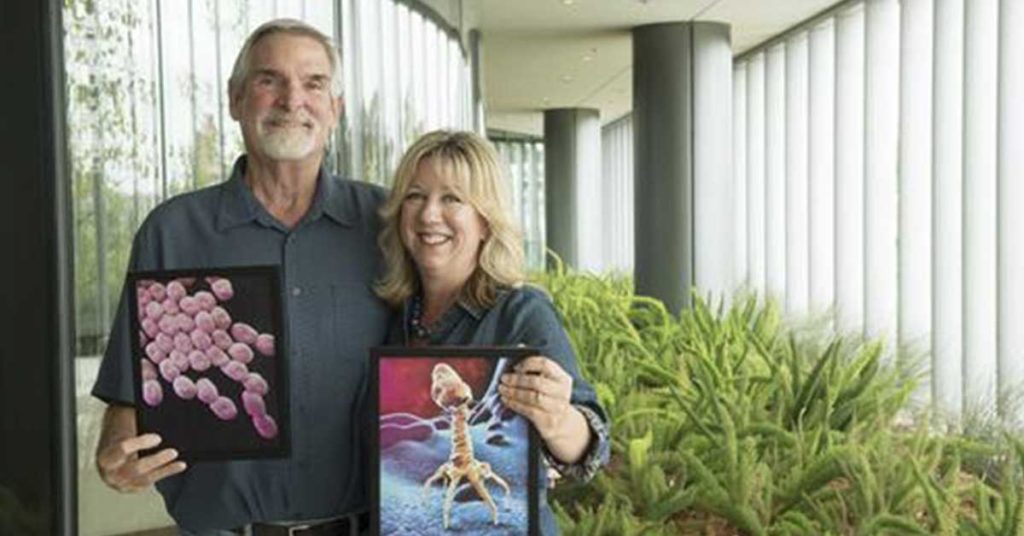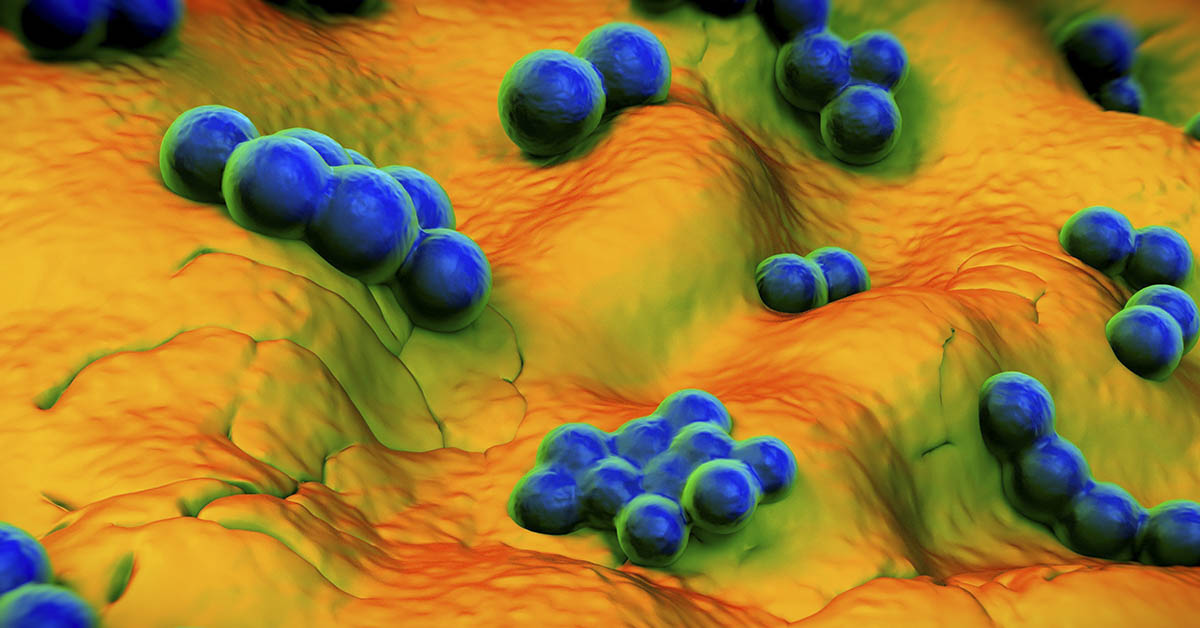When you have an infection, what do you do? Go to the doctor and get an antibiotic prescription, right? The antibiotics then make everything better. Only, their ability to do so is waning to the point where a crisis is brewing – a superbug crisis. These are bacteria that no existing antibiotics can destroy, making infections very serious and potentially even fatal. This woman found a solution to the superbug that was killing her husband in an unlikely place: A virus. Today he is alive to tell the tale.
Stopping The Superbug Crisis With Viruses
In February 2016, Stefanie Strathdee was about to lose her husband Tom to an infectious bacteria that had taken over his body. A part of the growing superbug crisis, not a single antibiotic or other medication could stop the bacteria that was ravaging his body. The infectious disease epidemiologist took hold of her dying husband’s hand and asked him if he wanted to keep fighting, to give it a squeeze. After a few agonizing pauses, he squeezed her hand as firmly as he could. With that confirmation, she set to work figuring out what she could do to save her husband’s life. (1)

Superbugs, Phages, Viruses, and Bacteria
Stefanie immediately began researching potential other options for treating bacterial infections that didn’t include traditional antibiotics. That’s when she came across phages, or viruses created by nature to eat bacteria. These viruses exist as a natural “predator”, you could say, of bacteria to keep bacteria populations in check. The next problem was then finding people who’d be willing to track down which phages might work against this specific bacteria and turn it into a treatment for her husband. From there, she has to get the FDA to allow them to use it, and then the scientists have to purify it enough so that it doesn’t kill her husband in the process of killing the bacteria. All of this, of course, was a huge task.
Tom’s battle was against the deadly superbug bacteria Acinetobacter baumannii. This dangerous bug is resistant to pretty much all antibiotics and has been killing people for years. It is at the top of the World Health Organization’s list of dangerous pathogens. The WHO says that we are in critical need of new drugs and antibiotics to tackle this beast. Unfortunately, they still do not exist.
Hard Work and The Kindness of Strangers
Stefanie came across a study from Tbilisi, the capital city of the country Georgia in Eastern Europe. What she then found was that phage treatment was actually well-researched and established in former Soviet nations. Western science, however, had discounted it long ago. Phages – these viruses that eat bacteria – are extremely abundant in nature – scientists guess about 10 million trillion trillion (that’s not a typo) of them exist on the planet. The issue is finding the right one to kill the right kind of bacteria.
“They’re in soil, they’re in water, in our oceans and in our bodies, where they are the gatekeepers that keep our bacterial numbers in check. But you have to find the right phage to kill the bacterium that is causing the trouble.” Stefanie said.

Stefanie began cold-calling scientists and reaching out to complete strangers asking for their help. She was able to convince biochemist Ryland Young of Texas A&M, who had been working with phages for the last 45 years. When he heard her story, he and his team got to work straight away.
“We just dropped everything. No exaggeration, people were literally working 24/7, screening 100 different environmental samples to find just a couple of new phages.”
Help in Surprising Places
While Young and his team were searching for the right phage, Stefanie and Tom’s long-time friend infectious disease specialist Dr. Robert Schooley was working on getting FDA approval to use the experimental treatment. This case fell under the category of “compassionate use” because it had never undergone clinical trials in the United States. It is a long process that requires immense amounts of documentation. Thankfully, when Schooley called the FDA, he, too, was met with kindness.
“‘No problem. This is what you need, and we can arrange that,’ ” Schooley said the woman from the FDA said. “And then she tells me she has friends in the Navy that might be able to find some phages for us as well.”
That’s when the Navy got involved, searching for phages from seaports around the world. Their scientists began searching, and before long they found some that seemed to work against Tom’s bacteria. Young and his team also had found some. From there, they had to separate out the successful phages from the toxic bacterial goo that gets left behind. Purifying phage to then deliver intravenously was not yet perfected in the United States. Between the Navy and the Texas A&M researchers, however, the figured it out.
Read: The woman whose own immune system possibly cured her of HIV
More Blockades
Legal staff at Texas A&M began to get squeamish about potential future lawsuits that could come from injecting unapproved viruses into a human being. Thankfully, Stefanie had the chancellor and those involved with human experimentation at UC San Diego on speed dial. She called them, who then called those at Texas A&M, and then magically any blockade disappeared. They were ready to inject the phages into Tom.
The first set arrived from Texas A&M, where they began by injecting them into his abdominal abscesses. They did this first to wait and see how Tom reacted before trying the intravenous ones. He responded well, so they continued treatment. Two days later, the phages from the Navy arrived and they injected them intravenously. Three days later, Tom was out of his coma and was even able to lift his head off the pillow.
Six years later, Tom is retired, walks three miles every day, and enjoys gardening and traveling the world with his wife. It is not perfect: The illness left him with diabetes, mild heart damage, gut damage that affects his diet, and no feeling in the bottoms of his feet. He is alive, however, and enjoying life with his family. Stefanie, along with the Navy and Texas A&M researchers, achieved a miracle.

The Superbug Crisis
The superbug crisis is another way of saying the antibiotic-resistant bacteria crisis. Already, superbugs kill more than 700,000 people every year. The WHO predicts that by 2050, this number could reach 10 million – if we don’t start developing new antibiotics and antimicrobial medications now. Scientists are ready and willing to develop what is needed. Unfortunately, it is the market that is slowing them down and even preventing them. The other issue is the overuse and misuse of antibiotic medicines which have increased the number of resistant bacteria. (2)
To solve the problem, first doctors must prescribe antibiotics less, only having patients take them when it is truly necessary. Second, doctors must be better about educating patients on what antibiotics do and why it is important that they follow their instructions for taking them. This includes letting them know about the consequences of not following those instructions. Second, there needs to be a concerted global push to develop new antimicrobial drugs. This means fixing the market for creating new drugs. In its current state, the only way to describe that market is broken.
It costs $1 billion to develop a new antibiotic. The issue is that this is a huge risk for pharmaceutical companies who would most definitely lose money and never recoup the cost. Because of this there are now only three companies working on new antibiotics, and the progress is slow. Thankfully, there are movements to make improvements to this, such as the Developing an Innovative Strategy for Antimicrobial Resistant Microorganisms (DISARM) and Pioneering Antimicrobial Subscriptions to End Up Surging Resistance (PASTEUR) working to improve this.
Hopefully slowing down the increased volume of resistant bacteria and enabling companies and scientists to develop more medications will happen before we have a horrific superbug crisis on our hands.
Keep Reading: Woman’s ‘cancer vanished after using cannabis and magic mushrooms’
Sources
- “No antibiotics worked, so this woman turned to a natural enemy of bacteria to save her husband’s life.” CNN. Sandee LaMotte. July 26, 2022.
- “We need new antimicrobials to prevent the next infectious disease crisis.” Stat News. Kevin Outterson and John Rex. August 12, 2020.

